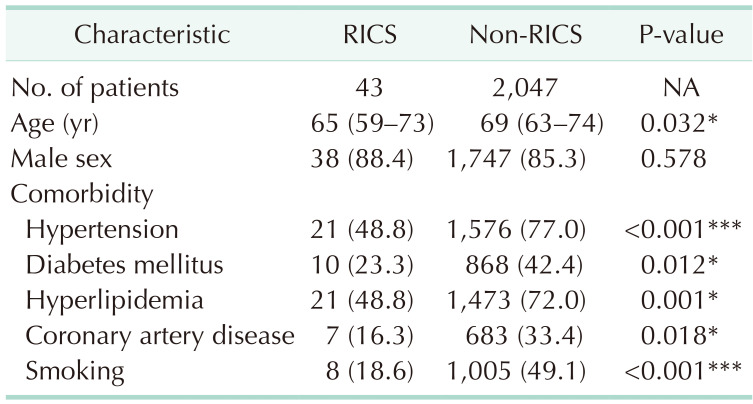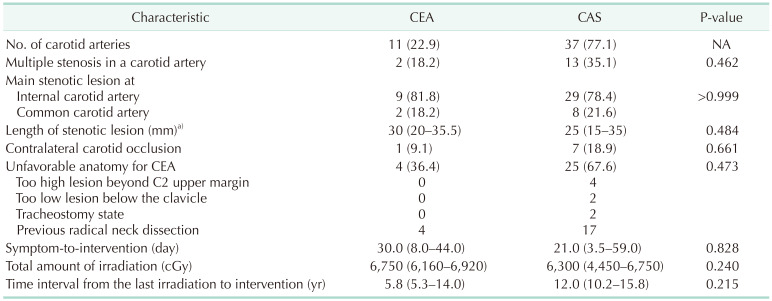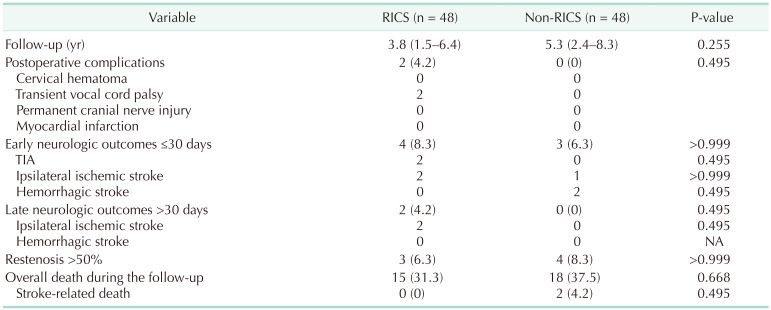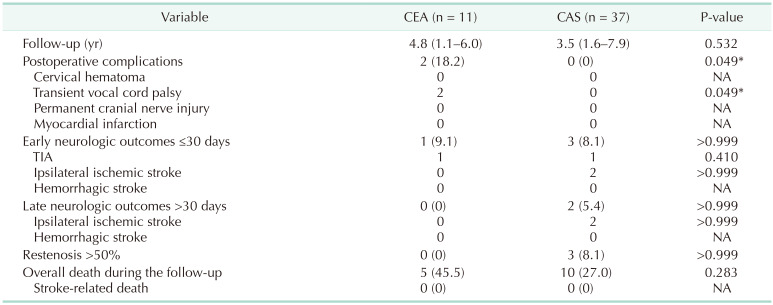1. Semrau R. The role of radiotherapy in the definitive and postoperative treatment of advanced head and neck cancer. Oncol Res Treat. 2017; 40:347–352. PMID:
28521321.

2. Wijerathne H, Langston JC, Yang Q, Sun S, Miyamoto C, Kilpatrick LE, et al. Mechanisms of radiation-induced endothelium damage: emerging models and technologies. Radiother Oncol. 2021; 158:21–32. PMID:
33581220.

3. Ravin RA, Gottlieb A, Pasternac K, Cayne N, Schneider D, Krishnan P, et al. Carotid artery stenting may be performed safely in patients with radiation therapy-associated carotid stenosis without increased restenosis or target lesion revascularization. J Vasc Surg. 2015; 62:624–630. PMID:
26304480.

4. Derubertis BG, Hynecek RL, Kent KC, Faries PL. Carotid tortuosity in patients with prior cervical radiation: increased technical challenge during carotid stenting. Vasc Endovascular Surg. 2011; 45:619–626. PMID:
21646237.

5. Hassen-Khodja R, Sala F, Declemy S, Lagrange JL, Bouillane PJ, Batt M. Surgical management of atherosclerotic carotid artery stenosis after cervical radiation therapy. Ann Vasc Surg. 2000; 14:608–611. PMID:
11128455.

6. Tallarita T, Oderich GS, Lanzino G, Cloft H, Kallmes D, Bower TC, et al. Outcomes of carotid artery stenting versus historical surgical controls for radiation-induced carotid stenosis. J Vasc Surg. 2011; 53:629–636. PMID:
21216558.

7. Fokkema M, den Hartog AG, Bots ML, van der Tweel I, Moll FL, de Borst GJ. Stenting versus surgery in patients with carotid stenosis after previous cervical radiation therapy: systematic review and meta-analysis. Stroke. 2012; 43:793–801. PMID:
22207504.

8. North American Symptomatic Carotid Endarterectomy Trial Collaborators. Barnett HJ, Taylor DW, Haynes RB, Sackett DL, Peerless SJ, et al. Beneficial effect of carotid endarterectomy in symptomatic patients with high-grade carotid stenosis. N Engl J Med. 1991; 325:445–453. PMID:
1852179.
9. Lucas J, Mack WJ. Effects of ionizing radiation on cerebral vasculature. World Neurosurg. 2014; 81:490–491. PMID:
24444794.

10. Scott AS, Parr LA, Johnstone PA. Risk of cerebrovascular events after neck and supraclavicular radiotherapy: a systematic review. Radiother Oncol. 2009; 90:163–165. PMID:
19171403.

11. Sugihara T, Hattori Y, Yamamoto Y, Qi F, Ichikawa R, Sato A, et al. Preferential impairment of nitric oxide-mediated endothelium-dependent relaxation in human cervical arteries after irradiation. Circulation. 1999; 100:635–641. PMID:
10441101.

12. Fokkema M, den Har tog AG, van Lammeren GW, Bots ML, Pasterkamp G, Vink A, et al. Radiation-induced carotid stenotic lesions have a more stable phenotype than de novo atherosclerotic plaques. Eur J Vasc Endovasc Surg. 2012; 43:643–648. PMID:
22436263.

13. Ting AC, Cheng SW, Yeung KM, Cheng PW, Lui WM, Ho P, et al. Carotid stenting for radiation-induced extracranial carotid artery occlusive disease: efficacy and midterm outcomes. J Endovasc Ther. 2004; 11:53–59. PMID:
14748628.

14. Favre JP, Nourissat A, Duprey A, Nourissat G, Albertini JN, Becquemin JP, et al. Endovascular treatment for carotid artery stenosis after neck irradiation. J Vasc Surg. 2008; 48:852–858. PMID:
18723311.

15. Dorresteijn LD, Vogels OJ, de Leeuw FE, Vos JA, Christiaans MH, Ackerstaff RG, et al. Outcome of carotid artery stenting for radiation-induced stenosis. Int J Radiat Oncol Biol Phys. 2010; 77:1386–1390. PMID:
20116932.

16. Yu SC, Zou WX, Soo YO, Wang L, Hui JW, Chan AY, et al. Evaluation of carotid angioplasty and stenting for radiation-induced carotid stenosis. Stroke. 2014; 45:1402–1407. PMID:
24699055.

17. Renard R, Davaine JM, Couture T, Jayet J, Tresson P, Gaudric J, et al. Surgical repair of radiation-induced carotid stenosis. J Vasc Surg. 2020; 72:959–967. PMID:
32035779.

18. Lesèche G, Castier Y, Chataigner O, Francis F, Besnard M, Thabut G, et al. Carotid artery revascularization through a radiated field. J Vasc Surg. 2003; 38:244–250. PMID:
12891104.

19. Batarseh P, Parides M, Carnevale M, Indes J, Lipsitz E, Koleilat I. Perioperative outcomes of carotid endarterectomy and transfemoral and transcervical carotid artery stenting in radiation-induced carotid lesions. J Vasc Surg. 2022; 75:915–920. PMID:
34560219.

20. Heo SH, Yoon KW, Woo SY, Park YJ, Kim YW, Kim KH, et al. Editor’s choice: comparison of early outcomes and restenosis rate between carotid endarterectomy and carotid artery stenting using propensity score matching analysis. Eur J Vasc Endovasc Surg. 2017; 54:573–578. PMID:
28893482.

21. Eckstein HH, Ringleb P, Allenberg JR, Berger J, Fraedrich G, Hacke W, et al. Results of the Stent-Protected Angioplasty versus Carotid Endarterectomy (SPACE) study to treat symptomatic stenoses at 2 years: a multinational, prospective, randomised trial. Lancet Neurol. 2008; 7:893–902. PMID:
18774746.

22. Tu J, Wang S, Huo Z, Wu R, Yao C, Wang S. Repeated carotid endarterectomy versus carotid artery stenting for patients with carotid restenosis after carotid endarterectomy: systematic review and meta-analysis. Surgery. 2015; 157:1166–1173. PMID:
25840718.






 PDF
PDF Citation
Citation Print
Print







 XML Download
XML Download